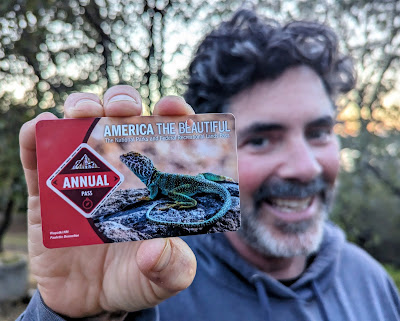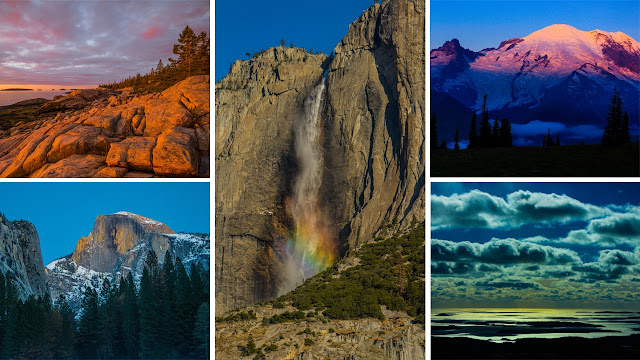Calling All U.S. National Park Nerds - National Park Week Trivia 2025!
Love National Parks? As self-proclaimed National Park Nerds who have visited nearly every national park in the nation, we’ve made it an annual tradition to share our own National Park Week Trivia Game to celebrate this fun week!
Explore The Dyrt PRO campground locator app to learn about all the cool features it has to find camping across the U.S. Get 30 days for FREE on us!
Harvest Hosts and Boondockers Welcome offer unique RV overnight stays near the parks (or in between) on a national park road trip!
With a few key resources in your back pocket, you'll be amazed at how much money you'll save on camping fees...and how much fun you'll have doing it!
Save 20% off an annual membership with the links above and our "CANLIFE20" promo code at check out.
READY FOR SOME TRIVIA? Let's dive in!
P.S. Answers are at the end, along with a whole host of resources.
2. What do these U.S. national park images all have in common?
3. Briefly explain 1 thing that you've learned (while visiting any U.S. national park) that has blown your mind! Here are images of a few that have blown ours. P.S. There are so many possibilities, but no wrong answer here.
4. There are 4 distinct North American desert ecosystems. Name each of these 4 deserts and 1 national park located within its ecosystem.
5. What do these U.S. national park images have in common?
6. How many U.S. national parks are located EAST of the Mississippi River? Which are most fascinating to you and why? HINT: This one is TRICKY!
7. Yosemite (CA), Acadia (ME), and Mount Rainier (WA) seem like very different parks upon first glance, but they were all significantly shaped by similar geological forces. What were these MAJOR geological forces?
8. What's the #1 rule when visiting any of the 63 national parks (or 433 NPS units for that matter)? What do YOU do to accomplish this rule?
BONUS Question: Which US. National Park are you closest to right now? Use this map to find out!
ANSWERS
Answer 1:
There are 9 NPS sites which manage bison herds, 7 of which are national parks. The parks include: Badlands (SD), Grand Canyon (AZ), Grand Tetons (WY), Theodore Roosevelt (ND), Wind Cave (SD), Wrangell-St Elias (AK), and Yellowstone (MT, WY, ID). Blackfoot tribal leaders recently reintroduced a small herd from Elk Island NP in Canada onto Blackfeet land near Glacier NP (MT), but their range does not yet include the park.
Answer 2:
California! There are 9 very diverse national parks in California (the most of any U.S. state), followed closely by Alaska with 8 national parks. California's parks include: Channel Islands, Death Valley, Joshua Tree, Kings Canyon, Lassen Volcanic, Pinnacles, Redwood, Sequoia, and the stunning park where we are celebrating NPW with friends....Yosemite!
Answer 3:
No wrong answers for this one; thanks for sharing your great insights! As naturalists and geology nerds, we are personally blown away by how our parks were formed -- from the shallow island seas that once covered much of the west to the uplift of the Colorado plateau, from the volcanos and glaciers that shaped so many of our favorite parks to the endemic species that call them home. With curious minds and a few key resources in our back pockets, we've often said that the past 12 years of exploring and volunteering in our national parks has been a self-designed PhD program. We can learn SO MUCH from the natural world if we keep our eyes open!
Answer 4:
The 4 North American deserts are the Sonoran, Mojave, Chihuahuan, and Great Basin. Each has a very distinct ecosystem with different flora and fauna, including many endemic species!
There are several national parks within these 4 deserts including: Big Bend, White Sands, and Guadalupe (Chihuahuan Desert); Saguaro and part of Grand Canyon (Sonoran Desert); Joshua Tree, part of both Death Valley and Grand Canyon (Mojave Desert); and Great Basin and part of Death Valley (Great Basin Desert)...among others!
To learn more about exploring these fascinating regions, check out this article.
There are several national parks within these 4 deserts including: Big Bend, White Sands, and Guadalupe (Chihuahuan Desert); Saguaro and part of Grand Canyon (Sonoran Desert); Joshua Tree, part of both Death Valley and Grand Canyon (Mojave Desert); and Great Basin and part of Death Valley (Great Basin Desert)...among others!
To learn more about exploring these fascinating regions, check out this article.
Answer 5:
Wyoming! All of the images are from the neighboring national parks of Yellowstone & Grand Tetons -- specifically within the state of Wyoming. FUN FACT! Yellowstone NP actually spans 3 states (Wyoming, Montana, and Idaho).
Answer 6:
As of 2025, we have 14 beautiful national parks located EAST of the Mississippi River -- Acadia (ME), Biscayne (FL), Congaree (SC), Cuyahoga Valley (OH), Dry Tortuga (FL), Everglades (FL), Great Smoky Mountains (NC/TN), Indiana Dunes (IN), Isle Royale (MI), Mammoth Cave (KY), New River Gorge (WV), Shenandoah (VA), Voyageurs (MN)...and let's not forget the U.S. Virgin Islands NP!
Answer 7:
While Yosemite, Acadia, and Mount Rainier are located all over our country, they were all significantly shaped by fire and ice -- volcanos/bubbling magma and carved by glaciers. How can you tell? If granite is present, there were volcanos/plutons involved in the park/region's formation as granite is a type of igneous (volcanic) rock. Granite is one of the hardest rocks known, often called the "rock of ages" because it is not easily eroded or damaged. During the last ice age, glaciers (massive mountain moving bulldozers) carved this granite -- leaving soft, rounded tops to all of the mountains. While the volcanic activity (plutons) that formed both Acadia and Yosemite is no longer active and the glaciers that carved them melted around 10-12K years ago, Mount Rainier still boasts BOTH an active volcano, and is the most glaciated peak in the contiguous U.S., spawning five major rivers!
Answer 8:
The 7 Leave No Trace Principles are incredibly important and should be practiced EVERYWHERE you travel, but the #1 NPS rule is do NOT approach or feed wildlife -- either purposely or inadvertently by leaving food, crumbs, or smelly trash behind! This includes chipmunks, birds, bears....and every animal in between. Simply put, our diet is not their diet. They may beg and show off so that you will give them chips, bread, and cookies, but eventually it will kill them. If animals become dependent on human food, they won't work to find their own. And, if more aggressive animals (e.g., bears, bison, alligators) become habituated to human food, they may attack and/or have to be euthanized. Bottomline, if you love wildlife, PLEASE do NOT feed them!
6-8 Correct Answers: Amazing work! Welcome to the National Park Nerd club.
3-5 Correct Answers: Well done! A great start...you have a lot of fun learning ahead of you.
1-2 Correct Answers: Start planning your National Park road trip to learn more about America's national treasures!
Want to learn more? As both National Park Nerds and RV Lifestyle Educators who teach at RV shows across the country, we have quite a collection of resources that we use to plan, research, and learn about our parks. We've made these helpful resources available FREE to the public on our website to encourage people to not just visit our parks, but truly explore them and take the time to learn about their fascinating history, geology, flora and fauna, and their future!
This blog includes our affiliate links.
WE receive a small commission and YOU receive a discount
when you purchase using our links and promo codes.














Comments
Post a Comment